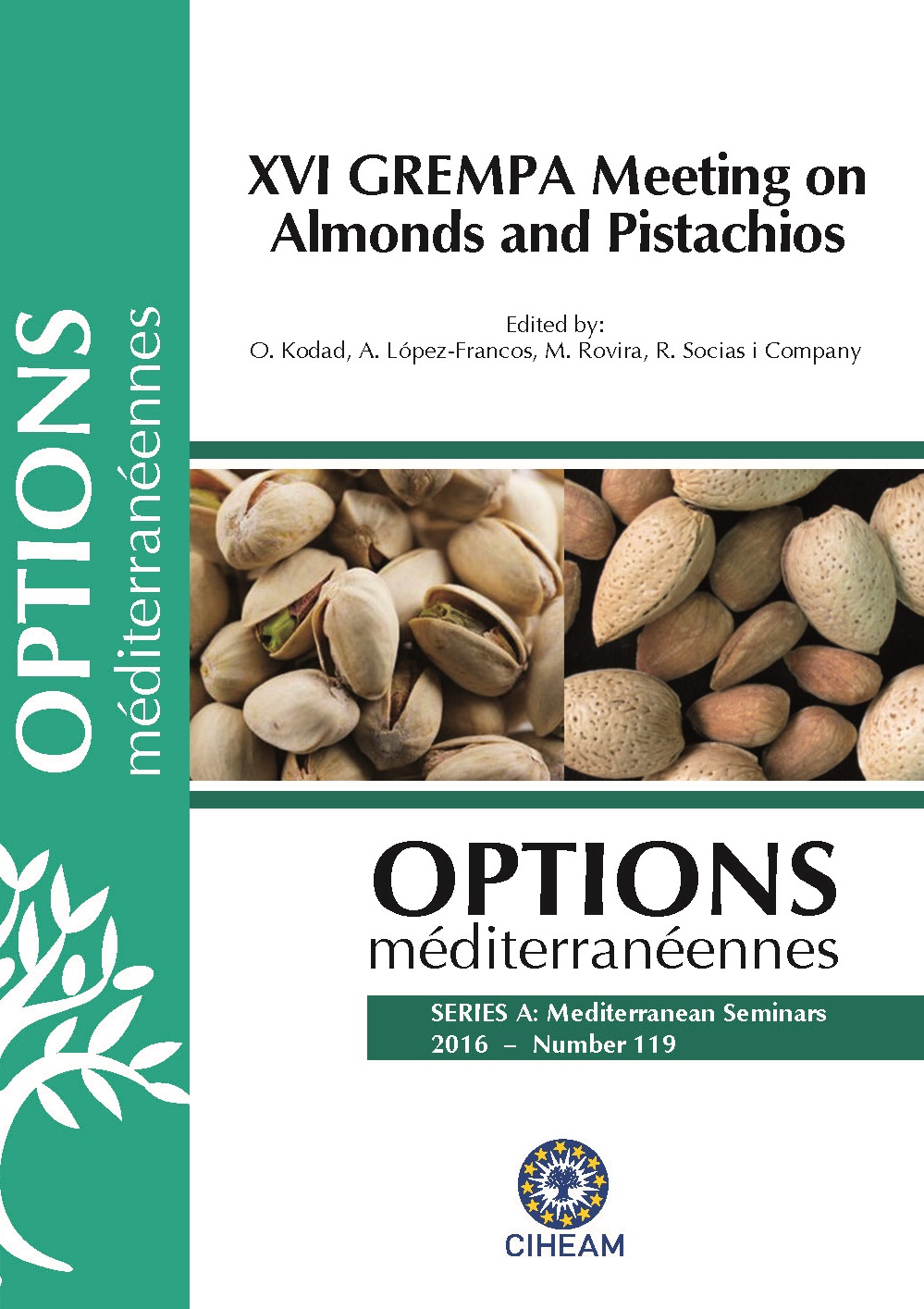| Article précédent | p. 133-143 | Article suivant |
Almond Rootstocks: Overview
Almond growing has significantly changed over the last decades in the. Production has decreased in some countries such as but in others, including, an important change has taken place. The possibilities for choosing a rootstock have also significantly increased. The use of almond seedlings has always been linked to rainfed conditions and peach seedlings to irrigated conditions. The peach x almond hybrid ‘GF- has been the rootstock most utilized in the past years, either for rainfed or irrigated conditions. Nowadays, however, with the high demand for these crops and the new areas planted in substitution of other fruit crops, new rootstock releases are being used more often, mainly newly-bred Spanish rootstocks. The rootstock choice must respond to better management, adaptability to different soil types, and resistance to nematodes. The studies of compatibility with plum species, especially the selection and use of some clonal almond x peach hybrid rootstocks have increased the selection possibilities considerably. In this situation, the red-leaved and rootknot nematode-resistant almond x peach hybrids (GxN) that are well adapted to Mediterranean conditions due to their ‘Garfi’ parentage, in both irrigated and non-irrigated conditions (mainly ‘Garnem’), have become the predominant rootstocks. Particularly noteworthy among the recent releases has been the incorporation of root-knot nematode (RKN) resistance. Special emphasis has also been placed on developing dwarfing rootstocks for high-density orchard systems. New hybrid rootstocks of complex origin are now under experimentation and initial results indicate that they could improve almond production if they fulfil the requirements of modern fruit growing, as discussed in this revision.
La culture de l’amandier a évolué au cours des dernières décennies dans le bassin méditerranéen. Bien que dans certains pays, comme en Italie, la production ait diminué, dans d’autres, comme l’Espagne, a eu lieu un changement rapide. Les possibilités de choix des porte-greffes ont également connu une avancée significative. L’utilisation de semis d’amandier a toujours été liée à des conditions non irriguées et le semis de pêchers à des conditions irriguées. Le pêcher*amandier ‘GF-677’ a été le porte-greffe le plus utilisé dans les dernières années, que ce soit pour les cultures irriguées ou non. Cependant de nos jours, suite à la forte demande de cette culture et au nombre de surfaces plantées en substitution d’autres cultures fruitières, il y a une utilisation croissante des nouvelles obtentions, notamment des nouveaux porte-greffes espagnols. Le choix des porte-greffes doit répondre à une bonne adaptation aux différents types de sol, au système de culture et à la résistance aux nématodes. Les études de compatibilité avec des espèces de pruniers et spécialement la sélection et l’utilisation de certains porte-greffes hybrides clonaux entre amandier x pêcher ont notamment accru les possibilités de choix du matériel végétal. Dans cette situation, les hybrides amandier x pêcher à feuilles rouges et résistants aux nématodes à galles (GxN) bien adaptés aux conditions méditerranéennes en raison de leur parent amandier ‘Garfi’, à la fois dans des conditions irriguées et non irriguées spécialement ‘Garnem’, sont devenus les porte-greffes prédominants. Particulièrement remarquable parmi les obtentions récentes a été l’incorporation de la résistance aux nématodes à galles (RKN). Uun accent particulier a été mis aussi sur le développement des porte-greffes de nanisme pour les systèmes de vergers à haute densité. De nouveaux porte-greffes hybrides complexes sont maintenant en expérimentation au champ et les premiers résultats indiquent qu’ils pourraient améliorer la production d’amandes s’ils remplissent les nouvelles exigences des cultures fruitières, comme il est montré dans cette révision
- [ Afficher ]
- [ Télécharger ]
- [ Exporter la citation ]
Vous pouvez télécharger la citation au format :
- [ Imprimer ]
-
Mots-clés
AGRICULTURE INTENSIVE, NEMATODE, PRUNUS DULCIS, SECHERESSECiter cet article
Rubio-Cabetas J.M. Almond Rootstocks: Overview. In : Kodad O. (ed.), López-Francos A. (ed.), Rovira M. (ed.), Socias i Company R. (ed.). XVI GREMPA Meeting on Almonds and Pistachios. Zaragoza : CIHEAM, 2016. p. 133-143. (Options Méditerranéennes : Série A. Séminaires Méditerranéens; n. 119). 16. Meeting of GREMPA (Groupe de Recherches Méditerranéennes pour l\'Amandier et Pistachier / Mediterranean Research Group for Almond and Pistachio), 2015/05/12-14, Meknes (Morocco) . http://om.ciheam.org/om/pdf/a119/00007379.pdf



